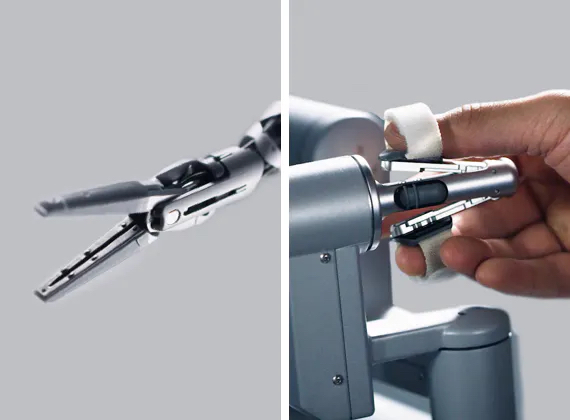A breakthrough in gynecologic surgery
Until recently, surgery for most gynecologic conditions was performed using a large abdominal incision. This is because while conventional laparoscopic surgery is effective for many routine procedures, the long-handled, rigid instruments used in laparoscopy are not usually considered effective for delicate or complex operations.
Fortunately, there is a minimally invasive option for treating gynecologic conditions designed to overcome the limits of traditional open and laparoscopic surgery – da Vinci Surgery. If your doctor recommends a hysterectomy to treat your condition, you may be a candidate for da Vinci Surgery. Using state-of-the-art technology, a da Vinci® Hysterectomy requires only a few tiny incisions, so you can get back to your life faster.

The daVinci system is a state-of-the-art surgical platform with 3D, high-definition vision and miniaturized, wristed surgical instruments designed to help doctors take surgery beyond the limits of the human hand. By helping doctors to overcome the challenges of traditional open and laparoscopic surgery, da Vinci is changing the experience of surgery for women around the world.
Benefits
The da Vinci System enables your doctor to perform a minimally invasive hysterectomy even for complex conditions — with enhanced vision, precision, dexterity and control. da Vinci Hysterectomy offers women many potential benefits over traditional surgery, including:
- Less pain
- Fewer complications
- Less blood loss
- Shorter hospital stay
- Lower risk of wound infection
- Quicker recovery and return to normal activities
About Hysterectomies
Physicians perform hysterectomy – the surgical removal of the uterus – to treat a wide variety of uterine conditions. Each year in the U.S. alone, doctors perform approximately 600,000 hysterectomies, making it the second most common surgical procedure.
Approaches to Hysterectomy
There are two types of hysterectomy that are performed depending on the patient’s diagnosis:
- Supracervical hysterectomy – removes the uterus, leaves cervix intact
- Total hysterectomy – removes the uterus and cervix
Surgeons perform the majority of hysterectomies using an “open” approach, which is through a large abdominal incision. An open approach to the hysterectomy procedure requires a 6-12 inch incision.
A second approach to hysterectomy, vaginal hysterectomy, involves removal of the uterus through the vagina, without any external incision or subsequent scarring. Surgeons most often use this minimally invasive approach if the patient’s condition is benign (non-cancerous), when the uterus is normal size and the condition is limited to the uterus.
In laparoscopic hysterectomies, the uterus is removed either vaginally or through small incisions made in the abdomen. The surgeon can see the target anatomy on a standard 2D video monitor thanks to a miniaturized camera, inserted into the abdomen through the small incision. A laparoscopic approach offers surgeons better visualization of affected structures than either vaginal or abdominal hysterectomy.
While minimally invasive vaginal and laparoscopic hysterectomies offer obvious potential advantages to patients over open abdominal hysterectomy — including reduced risk for complications, a shorter hospitalization and faster recovery — there are inherent drawbacks. With vaginal hysterectomy, surgeons are challenged by a small working space and lack of view to the pelvic organs. Additional conditions can make the vaginal approach difficult, including when the patient has:
- A narrow pubic arch (an area between the hip bones where they come together)2
- Thick adhesions due to prior pelvic surgery, such as C-section3
- Severe endometriosis 4
- Non-localized cancer (cancer outside the uterus) requiring more extensive tissue removal, including lymph nodes
With laparoscopic hysterectomies, surgeons may be limited in their dexterity, since the instruments are straight and rigid, and by 2D visualization, both of which can potentially reduce the surgeon’s precision and control when compared with traditional abdominal surgery.
The da Vinci Difference
da Vinci Hysterectomy, combines the advantages of conventional open and minimally invasive hysterectomies – but with potentially fewer drawbacks. The da Vinci Surgical System enables surgeons to perform surgical procedures with unmatched precision, dexterity and control.
For patients, the benefits of da Vinci Hysterectomy may include significantly less pain, less blood loss, fewer complications, less risk of infection, less scarring due to small incisions, shorter recovery time, a faster return to normal daily activities, and in many cases, better clinical outcomes.

Disclaimers
While clinical studies support the effectiveness of the da Vinci Surgical System when used in minimally invasive surgery, individual results may vary. There are no guarantees of outcome. All surgeries involve the risk of major complications. Before you decide on surgery, discuss treatment options with your doctor. Understanding the risks of each treatment can help you make the best decision for your individual situation. Surgery with the da Vinci Surgical System may not be appropriate for every individual; it may not be applicable to your condition. Always ask your doctor about all treatment options, as well as their risks and benefits. Only your doctor can determine whether da Vinci Surgery is appropriate for your situation. The clinical information and opinions, including any inaccuracies expressed in this material by patients or doctor about da Vinci Surgery are not necessarily those of Intuitive Surgical, Inc. and should not be considered as substitute for medical advice provided by your doctor.
© Intuitive Surgical. All rights reserved. Intuitive, Intuitive Surgical, da Vinci, da Vinci S, da Vinci Si, Single-Site, InSite,TilePro and EndoWrist are trademarks or registered trademarks of Intuitive Surgical. All other product names are trademarks or registered trademarks of their respective holders.
